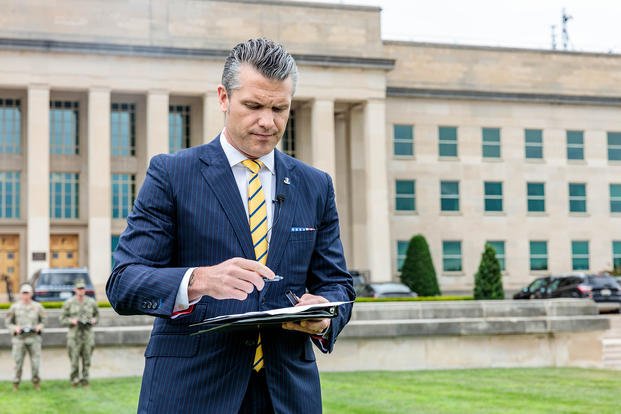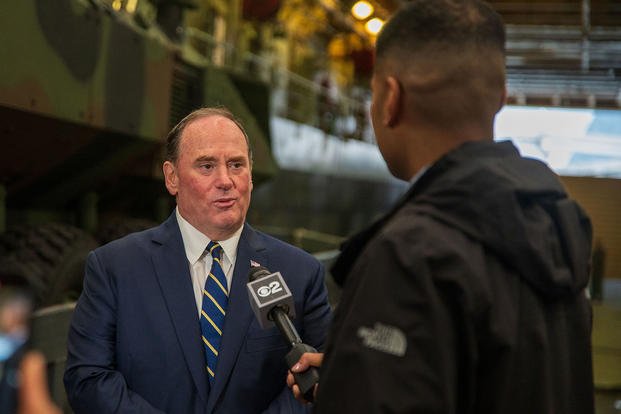For much of his tenure so far, Army Secretary Dan Driscoll has sought to present himself as a steady hand, disciplined and above the political fray. It's an image that has contrasted with the more overtly partisan messaging that now defines the Pentagon under the Trump administration.
But last week, Driscoll weighed in on a relatively obscure but politically charged matter -- the removal of the West Point crest from Bibles distributed in the academy's Cadet Chapel. In a statement to Fox News, Driscoll announced he had reversed the move, saying that removing the crests was "yet another example of the previous administration pushing far-left politics into our military institutions."
Removing the crests wasn't the result of some left-wing purge. Those Bibles were decades old and falling apart, multiple defense officials with direct knowledge of the situation told Military.com. The new editions, part of a fresh order of Bibles last year, omitted the ornate West Point crest as an easy means of saving money and still bore the words "United States Military Academy West Point, New York" in gold embossing.
Read Next: Navy Still Searching for Sailor Who Went Overboard During Exercise Near Australia
"This wasn't a controversy until someone decided to make it one," one senior Army official told Military.com on the condition of anonymity to avoid retaliation. "This type of stuff is damaging our organization."
As civilian military leaders seem increasingly intent on picking winning political and culture war fights, the Pentagon may also be looking to phase out the uniformed officers who lead public communication operations within the services. Driscoll's service, the Army, is set to place a civilian political operative from North Carolina in a role overseeing its communications -- a role historically held by a brigadier general -- and at least one other service seems to be weighing a similar change.
Removing those officers -- typically one-star generals or admirals -- would shift day-to-day messaging to the public under the purview of civilian political appointees.
The military's public communications have been deliberately apolitical, focused squarely on information about troops and preserving public trust -- under both Republican and Democratic administrations of the past. But they could soon be increasingly shaped by partisan considerations, according to multiple military public affairs officials who spoke to Military.com and expressed deep concerns over the move.
While it's not unusual for political hands to manage messaging at the highest levels of the Pentagon, the ongoing change to military public affairs marks a broader institutional pivot.
In the first six months of Defense Secretary Pete Hegseth's tenure, the former Fox News pundit has reshaped the Pentagon under his own political worldview, with cultural grievances becoming the defining theme of his tenure. The Pentagon's front-facing communications with the public -- and the troops -- have been laced with attacks on Democratic lawmakers, praise for President Donald Trump, political barbs and misinformation about media reports.

Meanwhile, the transformation to political leadership of public affairs shops is nearing completion within the Army, and the Navy may be next.
The results could be communications that seem more modern and attractive compared to the more traditional, dry tone the services tend to adopt for their public affairs messaging. But it also leads to the question of who is actually doing the speaking -- the service or a political appointee looking to bolster a partisan agenda or even please superiors.
Rebecca Hodson, a veteran of Republican campaign finance in North Carolina, will soon be taking over the reins for Army communications.
She earned her political bona fides fundraising for Sen. Ted Budd and former Sen. Richard Burr, both Republicans from the state. In 2021, she launched Brainstorm Consulting, a firm for down-ballot GOP candidates there. Among her top clients was Luke Farley, who unseated a Democratic incumbent in a tight race for labor commissioner. Farley's campaign shelled out nearly $43,000 to Hodson's firm, according to state filings.
Hodson will be backed by two longtime Army communications veterans. Steve Warren, who was a top adviser to former Army Secretary Christine Wormuth, and Col. Dave Butler, who served as a top aide to both Gen. Mark Milley and current Army Chief of Staff Randy George, will serve as her deputies.
Brig. Gen. Amanda Azubuike, the officer who ran the Army's public relations until last month, was effectively removed from office after a brief one-year tenure. She had been mostly sidelined after the November election, multiple public affairs officials with direct knowledge explained.
Amid the personnel changes, the Pentagon's traditionally apolitical messaging has often veered into echoing Trump's politics following his inauguration in January.
That uneasy dance with partisanship reached a boiling point in June, when Trump delivered a rally-style speech at Fort Bragg, with soldiers booing his political opponents in what many saw as a brazen politicization of the ranks.
As the messages have become more political, the Defense Department and some of the services, particularly the Army, have largely retreated to media they can control, including their own social media channels, which have been laced with misinformation. They've also largely shunned traditional media engagements, with officials opting for ideologically aligned spaces like Fox News, Breitbart radio, Steve Bannon's "War Room," and a spattering of niche podcasts.
None are places where officials are typically asked difficult questions or that provide information that reaches service members in any meaningful way.
In another example of the changing nature of public affairs, the Air Force rebranded one of its Facebook pages as "The Airman's Dispatch" where it directly communicates policy updates and service news to airmen, but to a casual observer the page may look like an outside news source. On the page's bio, it reads, "Truth moves fast. So do we."
In April, Navy Secretary John Phelan kicked off speculation that his service would also be upending the leadership of its communication staff when he announced in a social media post that his office had hired Kristina Wong, a former Breitbart reporter, to be "chief spokesperson for the Department of the Navy."
Like the Army at the time, the Navy has a one-star admiral who formally acts as the service's top spokesperson and a leader for a large community of public affairs officers. The post is held by Rear Adm. Ryan Perry.
Wong was, until her selection, a Pentagon reporter for Breitbart News, a right-wing news site that was run for nearly a decade by onetime Trump adviser and strategist Steve Bannon. Her role was later clarified to be the top spokeswoman for just Phelan, but questions continued to swirl around the future of the Navy's communications operations, especially as the typical three-year tenure for Perry's post came and went in early July.
The officer who seemed slated to replace Perry, Navy public affairs officer Capt. Jereal Dorsey, had his Biden-era nomination stalled, and eventually it was automatically canceled in January. Dorsey's prior assignments included being the spokesman for the now-fired Joint Chiefs Chairman Gen. Charles "CQ" Brown and Phelan's predecessor, Navy Secretary Carlos Del Toro.
Dorsey was renominated and finally confirmed in June, but Navy officials say he's been assigned to a department that doesn't oversee public affairs for the service.

Meanwhile, Perry seems to be without a replacement.
An official familiar with deliberations on the Navy public affairs office confirmed to Military.com that a variety of plans are being discussed but stressed that no decisions had been made.
The official also noted that those discussions were fluid and the leading idea for how the office would be run has varied from week to week, and sometimes even day to day.
Meanwhile, multiple Navy public affairs officers have told Military.com that they had concerns over the possibility of Perry being replaced by a civilian -- as the Army has done -- because of what it could mean for the future of Navy public affairs.
Uniformed communications chiefs sometimes lacked training in media relations or had little experience navigating the fast-paced press environment. Despite holding a one-star or admiral rank, they were often outranked by top Pentagon brass, a dynamic that sometimes led to awkward internal standoffs in which military hierarchy clashed with messaging tactics.
However, while officers like Perry and Azubuike are often billed as the top spokespeople for their respective services, leaders in their posts actually spend very little of their time dealing with questions from reporters or drafting statements.
Instead, one key aspect of their job is to lead their communities. This includes everything from providing fitness reports for more senior officers to ensuring that junior officers are taking jobs that would benefit them and their careers. These are also skills that a civilian with little knowledge of the military wouldn't possess.
-- Thomas Novelly contributed to this report.




